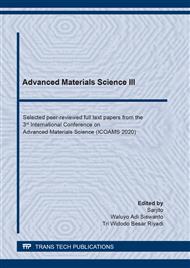[1]
D.M. Bernstein, B. Toth, R.A. Rogers, R. Sepulveda, P. Kunzendorf, J.I. Phillips, H. Ernst, Evaluation of the dose-response and fate in the lung and pleura of chrysotile-containing brake dust compared to chrysotile or crocidolite asbestos in a 28-day quantitative inhalation toxicology study, Toxicology and Applied Pharmacology 351 (2018) 74–92.
DOI: 10.1016/j.taap.2018.04.033
Google Scholar
[2]
D.L. Singaravelu, R. Vijay, P. Filip, Influence of various cashew friction dusts on the fade and recovery characteristics of non-asbestos copper free brake friction composites, Wear 426-427 (2019) 1129-1141.
DOI: 10.1016/j.wear.2018.12.036
Google Scholar
[3]
A.S. Darmawan, P.I. Purboputro, B.W. Febriantoko, The aluminum powder size' effect on rice plant fiber reinforced composite to hardness, wear and coefficient of friction of brake lining, IOP Conf. Series: Materials Science and Engineering 722 (2020) 012002.
DOI: 10.1088/1757-899x/722/1/012002
Google Scholar
[4]
N. Aranganathan, J. Bijwe, Development of copper-free eco-friendly brake-friction material using novel ingredients, Wear 352-353 (2016) 79–91.
DOI: 10.1016/j.wear.2016.01.023
Google Scholar
[5]
A. Ganguly, R. George, Asbestos free friction composition for brake linings, Bulletin of Materials Science 31(1) (2008) 19-22.
DOI: 10.1007/s12034-008-0004-6
Google Scholar
[6]
R. Yun, P. Filip, Y. Lu, Performance and evaluation of eco-friendly brake friction materials, Tribology International 43(11) (2010) 2010-2019.
DOI: 10.1016/j.triboint.2010.05.001
Google Scholar
[7]
A.S. Darmawan, P.I. Purboputro, B.W. Febriantoko, The effect of composition on hardness and wear resistance of rice plant fiber reinforced composite as a material of brake lining, IOP Conf. Series: Materials Science and Engineering 771 (2020) 012069.
DOI: 10.1088/1757-899x/771/1/012069
Google Scholar
[8]
A.S. Darmawan, P.I. Purboputro, B.W. Febriantoko, A. Hamid, Effect of pressure to rice plant fibre reinforced composite on coefficient of friction of brake lining, IOP Conf. Series: Materials Science and Engineering 851 (2020) 012020.
DOI: 10.1088/1757-899x/851/1/012020
Google Scholar
[9]
M. Amirjan, Microstructure, Wear and Friction Behavior of Nanocomposite Materials with Natural Ingredients, Tribology International 131 (2019) 184-190.
DOI: 10.1016/j.triboint.2018.10.040
Google Scholar
[10]
D. Plachá, M. Vaculík, M. Mikeska, O. Dutko, P. Peikertová, J. Kukutschová, K. Mamulová Kutláková, J. Růžičková , V. Tomášek, P. Filip, Release of volatile organic compounds by oxidative wear of automotive friction materials, Wear 376-377 (2017) 705-716.
DOI: 10.1016/j.wear.2016.12.016
Google Scholar
[11]
N. Aranganathan, V. Mahale, J. Bijwe, Effects of aramid fiber concentration on the friction and wear characteristics of non-asbestos organic friction composites using standardized braking tests, Wear 354-355 (2016) 69-77.
DOI: 10.1016/j.wear.2016.03.002
Google Scholar
[12]
M. May, G.D. Rupakula, P. Matura, Non-polymer-matrix composite materials for space applications, Composites Part C: Open Access 3 (2020) 100057.
DOI: 10.1016/j.jcomc.2020.100057
Google Scholar
[13]
Z. Ding, Y. Li, C. Lu, J. Liu, An Investigation of Fiber Reinforced Chemically Bonded Phosphate Ceramic Composites at Room Temperature, Materials 11 (2018) 858.
DOI: 10.3390/ma11050858
Google Scholar
[14]
M. Surappa, Aluminium Matrix Composites: Challenges and Opportunities, Sadhana 28(1) (2003) 319-334.
DOI: 10.1007/bf02717141
Google Scholar
[15]
S.A.A. Mohamed, M. El-Sakhawy, E.H.A. Nashy, A.M. Othman, Novel natural composite films as packaging materials with enhanced properties, International Journal of Biological Macromolecules 136 (2019) 774-784.
DOI: 10.1016/j.ijbiomac.2019.06.130
Google Scholar
[16]
J.L. Wang, Application of Composite Materials on Sports Equipments, Applied Mechanics and Materials 155-156 (2012) 903-906.
DOI: 10.4028/www.scientific.net/amm.155-156.903
Google Scholar
[17]
E. Sarikaya, H. Çallioğlu, H Demirel, Production of epoxy composites reinforced by different natural fibers and their mechanical properties, Composites Part B: Engineering 167 (2019) 461-466.
DOI: 10.1016/j.compositesb.2019.03.020
Google Scholar
[18]
D.K.K. Cavalcanti, M.D Banea, J.S.S Neto, R.A.A. Lima, R.J.C. Carbas, Mechanical characterization of intralaminar natural fibre-reinforced hybrid composites, Composites Part B: Engineering 175 (2019) 107149.
DOI: 10.1016/j.compositesb.2019.107149
Google Scholar
[19]
J. Zhou, Y. Li, L. Cheng, L. Zhang, Indirect Microwave Curing Process Design for Manufacturing Thick Multidirectional Carbon Fiber Reinforced Thermoset Composite Materials, Applied Composite Materials 26(2) (2019) 533-552.
DOI: 10.1007/s10443-018-9724-y
Google Scholar
[20]
V. Matějka, Z. Fu, J. Kukutschová, S. Qi, S. Jiang, X. Zhang, R. Yun, M. Vaculík, M. Heliová, Y. Lu, Jute fibers and powderized hazelnut shells as natural fillers in non-asbestos organic non-metallic friction composites, Materials & Design 51 (2013) 847-853.
DOI: 10.1016/j.matdes.2013.04.079
Google Scholar
[21]
B.H. Hadi, R.M.A. Alradha, The effect of utilization silicon & copper powders at the properties for epoxy resin (mechanical and physical), Advances in Natural and Applied Sciences 10(16) (2016) 37-42.
Google Scholar


